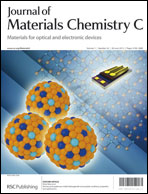Constructing a mixed π-conjugated bridge: a simple and effective approach to realize a large first hyperpolarizability in carbon nanotube-based systems†
Abstract
By means of ab initio calculations, a new concept of the mixed π-conjugated bridge is identified to significantly improve the first hyperpolarizability of a D–π–A system based on ![[double bond, length as m-dash]](https://www.rsc.org/images/entities/char_e001.gif) CH)x–NH2 chain to modify the end of the CNT system, which can effectively increase the degree of charge transfer and decrease the transition energy. This further results in a considerable first hyperpolarizability, much larger than that of the corresponding directly NH2-modified CNT system with the same conjugated length. In particular, the first hyperpolarizabilities of these tube–chain (CNT–(CH
CH)x–NH2 chain to modify the end of the CNT system, which can effectively increase the degree of charge transfer and decrease the transition energy. This further results in a considerable first hyperpolarizability, much larger than that of the corresponding directly NH2-modified CNT system with the same conjugated length. In particular, the first hyperpolarizabilities of these tube–chain (CNT–(CH![[double bond, length as m-dash]](https://www.rsc.org/images/entities/char_e001.gif) CH)x–NH2) systems can exhibit a monotonous increase with lengthening the –(CH
CH)x–NH2) systems can exhibit a monotonous increase with lengthening the –(CH![[double bond, length as m-dash]](https://www.rsc.org/images/entities/char_e001.gif) CH)x–NH2 chain. This overcomes the bottleneck encountered with pure CNT serving as the π-conjugated bridge: that further extending the CNT will not produce any positive effect on improving their first hyperpolarizabilities in CNT–NH2 configurations once the CNT reaches a certain length. Additionally, it is revealed that the length ratio of tube to chain can play a crucial role in increasing the first hyperpolarizabilities of these tube–chain motifs CNTl–(CH
CH)x–NH2 chain. This overcomes the bottleneck encountered with pure CNT serving as the π-conjugated bridge: that further extending the CNT will not produce any positive effect on improving their first hyperpolarizabilities in CNT–NH2 configurations once the CNT reaches a certain length. Additionally, it is revealed that the length ratio of tube to chain can play a crucial role in increasing the first hyperpolarizabilities of these tube–chain motifs CNTl–(CH![[double bond, length as m-dash]](https://www.rsc.org/images/entities/char_e001.gif) CH)x–NH2, and employing a –(CH
CH)x–NH2, and employing a –(CH![[double bond, length as m-dash]](https://www.rsc.org/images/entities/char_e001.gif) CH)x–NH2 chain with comparable conjugated size to substitute the end of the CNT (namely, l ≈ x) can be an effective approach to achieve an excellent NLO response in a CNT-based D–π–A framework. These findings can provide valuable information for the design of new high-performance NLO materials based on CNTs.
CH)x–NH2 chain with comparable conjugated size to substitute the end of the CNT (namely, l ≈ x) can be an effective approach to achieve an excellent NLO response in a CNT-based D–π–A framework. These findings can provide valuable information for the design of new high-performance NLO materials based on CNTs.


 Please wait while we load your content...
Please wait while we load your content...